Highlights
Highlights of IRG research are reported on an ongoing basis to the NSF MRSEC program.
2019
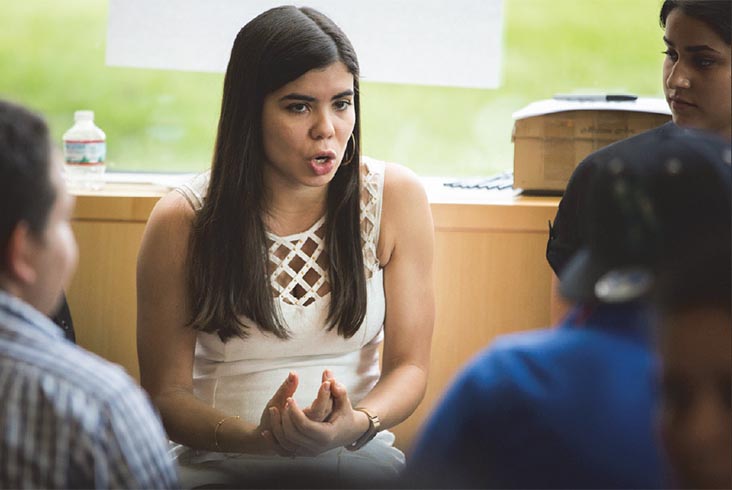
Working in small teams, MRSEC postdocs and graduate students discuss solutions to case studies.
Responsible Conduct of Research (RCR) courses are opportunities to prepare MRSEC scientists for tomorrow’s ethical scientific challenges. This year, the MRSEC Education team implemented a revised RCR curriculum for the entire Division of Science that was previously shown to be more effective than lectures and small-group discussion. Over 1.5 days, 30 faculty, 79 graduate students, and 27 postdocs participated in an education experiment designed to better engage participants during instruction and improve their ethical-decision making abilities. Before class, participants read an online textbook and took short auto-graded reading quizzes. In class, they worked in small interdisciplinary groups and discussed seven ethics topics, each with its own case study. MRSEC staff facilitated the full-class discussions using interactive technology. Integrated among learners, the faculty were able to assess participants’ understanding of the content in real time and appropriately address misconceptions. Feedback from both faculty and participants was very positive. A formal assessment will be done next year so that other MRSECs could adopt this model.
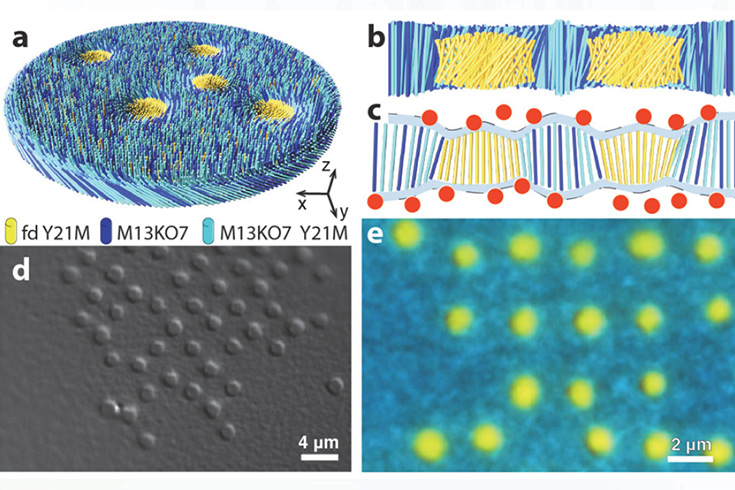
Colloidal rafts with switchable attractive and repulsive interaction. (top) Schematic and (bottom) optical microscopy images of colloidal rafts that assemble in membranes that have no net chirality. Differential interference microscopy (left) and fluorescence images (right) of colloidal rafts that assemble into crystalline lattices with unusual square symmetry. Such assemblages can be understood by measuring the effective membrane-mediated raft-raft interactions that can switch between repulsions and attractions and which are regulated by the raft chirality.
We describe hierarchical assemblages of colloidal rods that mimic some of the complexity and reconfigurability of biological structures. In particular, we show that chiral rod-like inclusions dissolved in an achiral colloidal membrane assemble into rafts, which are adaptable finite-sized liquid droplets that exhibit two distinct chiral states of opposite handedness. Interconverting between these two states switches the membrane-mediated raft interactions between long-ranged repulsions and attractions. Rafts with switchable interactions assemble into analogs of electrostatic complexation observed in charged particulate matter. A simple theoretical model explains these experimental findings. Our synergistic theoretical and experimental efforts results demonstrate a novel and highly robust pathway for self-assembly of reconfigurable colloidal superstructures, that does not depend on tuning the shape and interactions of the elemental units, but rather on the complexity of the emergent and still poorly understood membrane-mediated interactions.
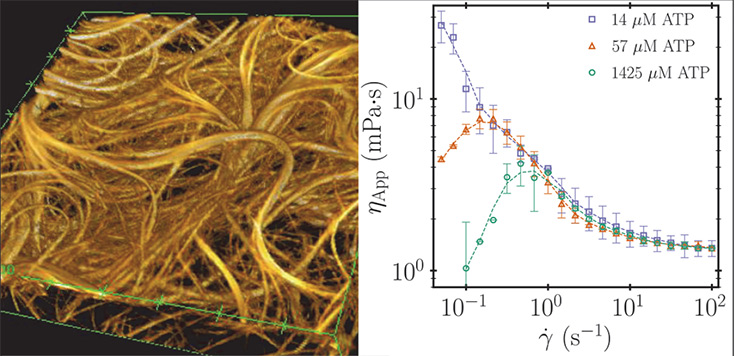
Structure and rheology of active gels: (left) A confocal reconstruction of an active gels composed of continuously rearranging extensile microtubule bundles that is driven by continuous input of energy through the motion of molecular motors. (right) Effective viscosity of a microtubule based active gels for three different ATP concentrations which controls the speed at which kinesin motors slide microtubules apart. The dashed lines represent a molecular model that explains the peak in the sample viscosity without any adjustable parameters.
Cytoplasmic flows, bacterial colonies, and algal blooms are ubiquitous examples of active suspensions assembled from self-propelled particles, which internally inject energy into their suspending medium and, at sufficient concentrations, can produce large-scale flows. Linking macroscale material properties of active suspension to their underlying microscopic dynamics is a key challenge to describing these materials. Relying on the unique properties of microtubule based active matter and state of the art rheological techniques we measured the shear-rate-dependent viscosity, yield stress, and local dynamics of a model active suspension, while simultaneously quantifying their microscopy dynamics and autonomous flows. Our microtubule suspensions form a transient network with long-range mechanical contacts mediated by motor proteins and are best described as active gels. We find that activity coupled with external shear dramatically alters their apparent viscosity. We develop a simple model to explain the fundamental connection between an external deformation and microscopic dynamics that produce an anomalous mechanical response in active gels.
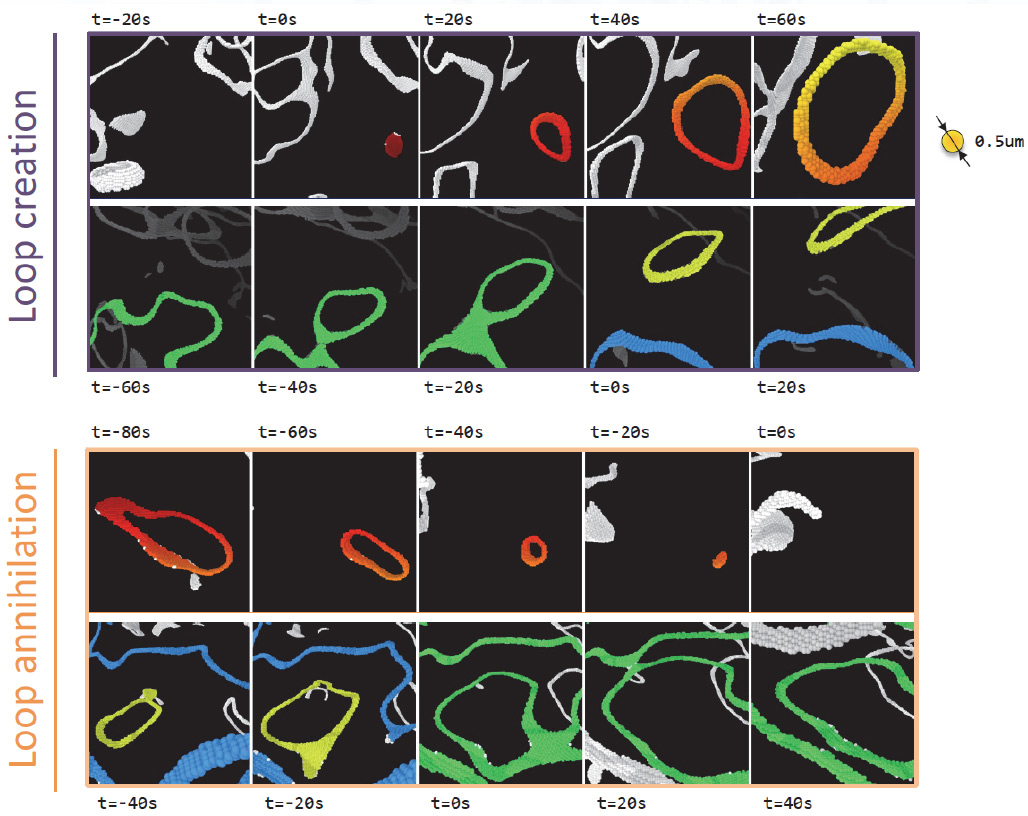
Dynamics of disclination loops in 3D active nematic. Topological loops can nucleate spontaneously from a uniformly aligned nematic through the bend instability. Loops can split from the existing percolating network. Equivalently, topological loops can also self-annihilate and merge with other existing loops. Colors highlight the loops of interest
Current active matter systems, such as self propelled colloids or migrating cells, are inherently 2D, which limits the potential engineering applications. Brandeis developed the first 3D active nematic material by mixing an isotropic active fluid (Microtubules + kinesin motors) with a passive nematic colloidal liquid crystal (fd viruses). Using multiview light sheet microscopy, they explored the structure and the dynamics of topological defects in a 3D active nematic.
Both experiments and 3D hydrodynamic simulations suggest that topological defects in the turbulent regime are curvilinear. The defects form a complex network of lines and closed loops where neutral disclination loops are the generic excitations of 3D active nematics. The neutral loops can spontaneously nucleate from a uniform background through the bend instability, or split from the pre-existing network. The loops can also self-annihilate by closing on themselves or merge with the rest of the network. These events have also been indentified in 3D hydrodynamic simulations.
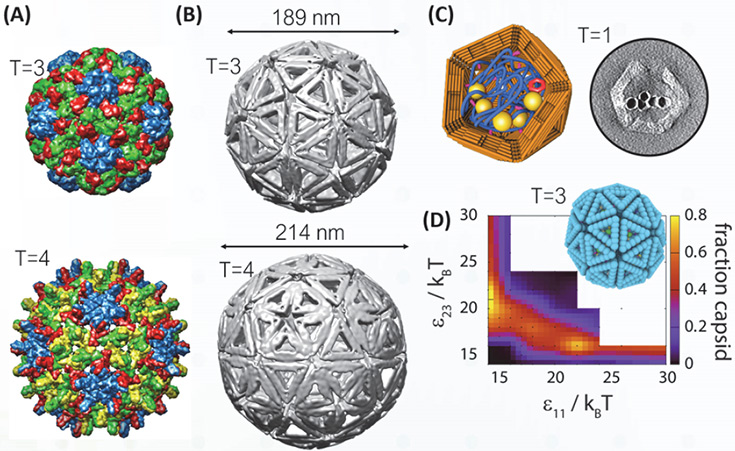
(A) Structures of icosahedral virus capsids, where T is the number of distinct local symmetry environments (indicated by color). (B) Cryo-electron microscopy reconstructions of DNA origami capsids. (C) (right) TEM tomogram of an origami capsid assembled around a DNA molecule labeled with gold nanoparticles. (left) Schematic of the structure. (D) Prediction of the yield T=3 capsid yield as a function of subunit-subunit interaction strengths that drive dimer formation (e11) and pentamer formation (e23), from Langevin Dynamic simulations.
DNA origami technology is used to develop building blocks that self-assemble into predetermined finite-sized structures. The objectives of this research are to understand, control, and build self-closing structures inspired by self-assembling viruses, whose smallest capsids have an icosahedral symmetry and are decomposable into so-called “quasi-equivalent” triangular subunit arrangements, characterized by the “T” number (Fig. 1A). Assembly occurs using programmed edge-edge interactions based on a lock-and-key mechanism and base stacking between the blunt ends of the double-helices. Researchers have successfully designed, assembled and characterized capsids of octahedral and icosahedral symmetry, including T1, T3, T4, and T9, and studied the determinants of capsid assembly experimentally and with a direct comparison to a computational model to test how the kinetics and yield of target structures depends on control parameters and assembly pathways (Fig. 1).

The three goals of SciLinkR.com and a screenshot of suggested “SciLinks.” SciLinkR.com uses algorithms to match users with each other (called “SciLinks”) and to existing examples of successful outreach (called “SciLinkReports”).
Bringing researchers into the classroom makes science and engineering practices come to life – and inspires underrepresented groups to pursue careers in STEM. However, for many researchers and educators the process of connecting with each is frustrating and unnecessarily complicated. To address this issue, this year, the Brandeis MRSEC developed and launched
SciLinkR.com, a national tool to simplify outreach and promote science. The site is intended to connect researchers and educators, engage them in meaningful outreach activities that are inspired by a repository of successful examples, and record the engagement with a citable digital object identifier. In the first six weeks after launch, the site attracted 179 users across the country and was recently described in a Brandeis publication. Over the next year, the goals are 1) to increase the number of new users and reports of engagement, 2) to increase SciLinkR facilitated engagements, and 3) to determine a sustainability plan for the future.